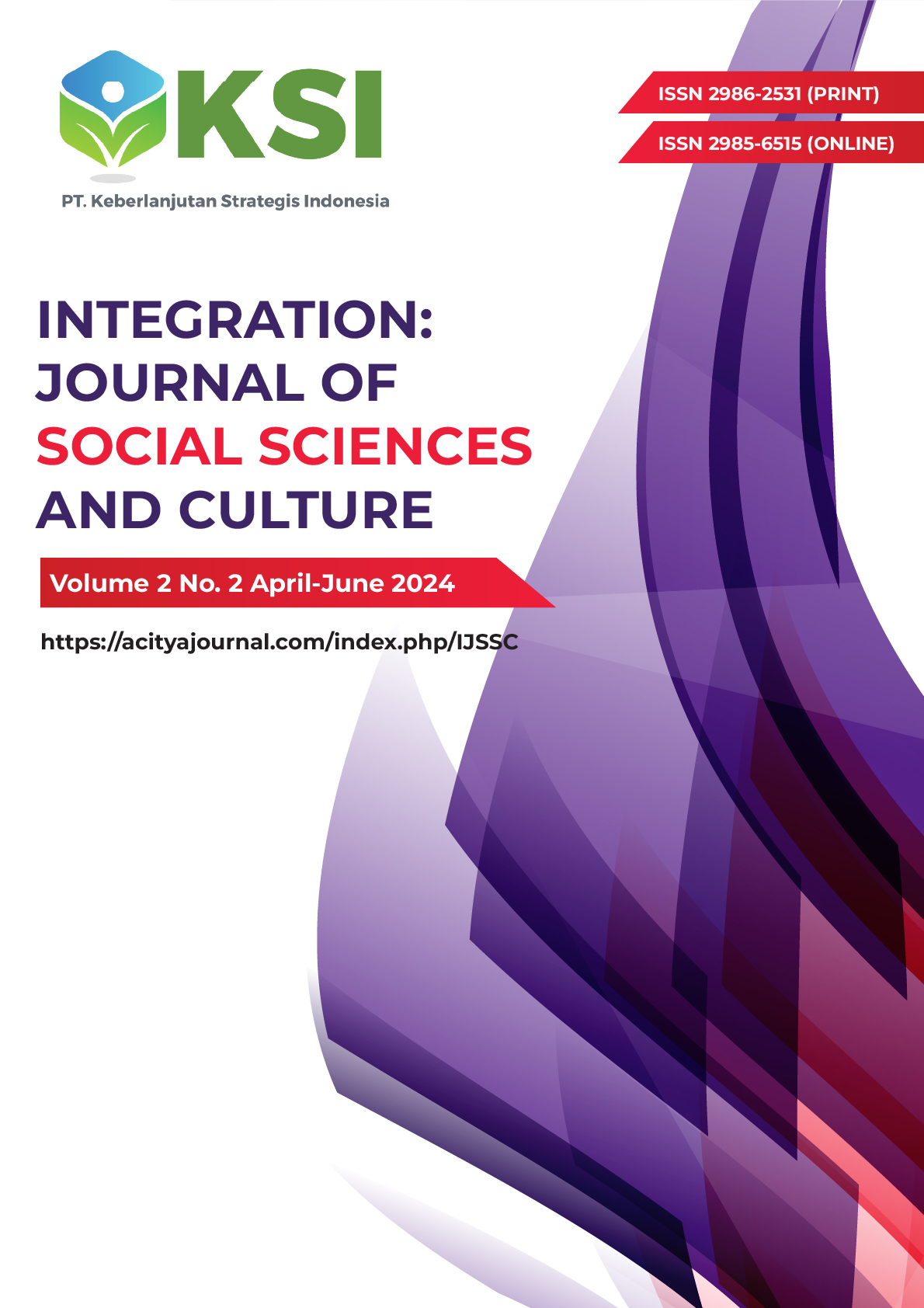The Impact of the Treaty of Hudaybiyyah on the Spread of Islam in the Arabian Peninsula
DOI:
https://doi.org/10.38142/ijssc.v2i2.220Keywords:
The Treaty of Hudaybiyyah, Letter to the Kings, Liberation of the City of MeccaAbstract
Purpose:
This research aims to analyze Muslims' main goals in the Treaty of Hudaibiyah and its impact on the relationship between Muslims and the Quraysh. The study focuses on the establishment of four points of the agreement, including a ceasefire, freedom of affiliation, rules for the return of individuals, and permission for pilgrimage the following year. The results of these negotiations caused Muslims to be disappointed.
Methodology:
This research uses a historical research method that consists of four stages: heuristics (gathering sources), criticism (selecting data), interpretation (interpreting data), and historiography (writing history).
Findings:
The research findings concluded that the Treaty of Hudaibiyah significantly impacted the spread of Islamic teachings in the Arabian Peninsula. With the agreement on a ceasefire, Muslims were able to spread the teachings of Islam freely. The Prophet Muhammad (peace be upon him) responded to the agreement by sending letters to the kings in Arabia and surrounding areas.
Implication:
The Treaty of Hudaybiyyah was a major factor in the liberation of the city of Mecca. It happened when the Banu Bakr, who was part of the treaty with the Quraysh, attacked Khuza’ah, who was part of the Islamic group. With the treaty broken and invalidated, the Prophet Muhammad (peace be upon him) then ordered 10,000 Muslim troops to head to Mecca with the aim of freeing Mecca from the shackles of disbelief and the ignorant behavior of the Quraysh people.
Downloads
References
Aizid, R. (2013). Sejarah Peradaban Islam Terlengkap. Yogyakarta: DIVA Press.
Alkhateeb, F. (2016). Sejarah Islam Yang Hilang Menelusuri Kembali Kejayaan Muslim Pada Masa Lalu (Vol. I). (M. Wijanarko, Penerj.) Yogyakarta: Bentang.
Al-Mubarakfury, S. R. (2008). Sirah Nabawiyah (Vol. 27). (K. Suhardi, Penerj.) Jakarta TImur: PUSTAKA AL-KAUTSAR.
Amanah, S., & Bashori. (1992). Sejarah Nabi Muhammad SAW. Semarang: Toha Putra.
Amstrong, K. (2007). Muhammad Prophet For Our Time. Bandung: Mizan.
Arake, L. (2019). Fiqh Diplomatik: Konsep dan Realita. Bantul: Lembang Ladang Kata.
Haekal, M. H. (1992). Sejarah Hidup Muhammad (Vol. XIII). (A. Audah, Penerj.) Jakarta: Litera Antar Nuansa.
Haif, A. A. (2014). Perjanjian Hudaibiyah (Cermin Kepiawaian Nabi Muhammad saw. dalam Berdiplomasi). Rihlah: Jurnal Sejarah dan Kebudayaan, 1(01), 119-131.
Hatta, A. (2016). The Great Story of Muhammad SAW (Vol. 6). Jakarta Timur: Maghfirah Pustaka.
Hisyam, I. (2018). Sirah Nabawiyah. (S. Rahman, Penerj.) Jakarta: Akbar Media.
Hitti, P. K. (2010). History of The Arabs (Vol. i). (D. S. R. Cecep Lukman Yasin, Penerj.) Jakarta: PT SERAMBI ILMU SEMESTA.
Iskandar, A. (2019). Hikmah Dibalik Perjanjian Hudaibiyah. Jurnal Studi Hadis Nusantara, 1(1).https://doi.org/10.24235/jshn.v1i1.5745
Katsir, I. (2005). Tafsirul Quranul Adzim. Kairo: Maktabah Islamiyah.
Katsir, I. (2010). Al-Bidayah wa-Nihayah (Vol. IV). Beirut: Dar Ibn Katsir.
Katsir, I. (2010). Al-Bidayah wa-Nihayah "In the Defence of the True Faith". (R. D. Darussalam, Penerj.) Riyadh: Maktaba Darussalam.
Kuntowijoyo. (2003). Metodologi Sejarah Edisi Kedua. yogyakarta: Tiara Wacana.
Kuntowijoyo. (2018). Pengantar Ilmu Sejarah. Yogyakarta: Tiara Wacana.
Mahmudunnasir, S. (2011). Islam Konsepsi dan Sejarahnya (Vol. 5). (D. A. Affandi, Penerj.) Bandung: PT. Remaja Rosdakarya.
Notosutanto, N. (1978). Masalah Penelitian Sejarah Kontemporer (Suatu Pengalaman). Jakarta: Yayasan Idayu.
Saddang, M. (2022). Nilai-Nilia Pendidikan Islam Pada Perjanjian Hudaibiyah Dalam Buku AL-Rahiq Al-Maktum. Al-Mutsla.
Siregar, A. S. (2023). Negosiasi Rasulullah Saw Dalam Mewujudkan Perjanjian Hudaibiyah. SEIKAT: Jurnal Ilmu Sosial, Politik dan Hukum, 2(2), 118-128. https://doi.org/10.55681/seikat.v2i2.458
Siregar, A. S. (2023). Negosiasi Rasulullah Saw Dalam Mewujudkan Perjanjian Hudaibiyah. SEIKAT: Jurnal Ilmu Sosial, Politik dan Hukum, 2(2), 118-128.https://doi.org/10.55681/seikat.v2i2.458
Syallabi, A. (1995). Attarikhul Islami Walhadharatul Islamiyah. (M. Yahya, & M. S. Latief, Penerj.) Jakarta: Al-Husna Zikra.
Thabari, M. I. (1885). Tarikh Ar-Rusul wal Mulk (Vol. 3). Netherlands: Lughdunum Batavorum: E. J. BRILL.
Thabari, M. I. (2001). Tafsir At-Thabari min Kitabihi Jami'ul Bayan 'An Wa'wili Ayat Al-Qur'an. Kairo: Dar Hijr.
Tulus, P., & Surwandono. (2015, December). "Diplomasi Bersih" Dalam Perspektif Islam. Thaqafiyyat vol. 16 no. 2, 150.
Usman, H. (1986). Metode Penelitian Sejarah. (M. '. dkk, Penerj.) Jakarta: Departemen Agama.
Wahyudiyanto, D. (2022). Strategi Negosiasi Nabi Muhammad Saw pada Perjanjian Hudaibiyah dalam Perspektif Analisis Pentad. INTELEKSIA: Jurnal Pengembangan Ilmu Dakwah, 4(1), 157-178. https://doi.org/10.55372/inteleksiajpid.v4i1.225
Yusuf, M. Y. (2016). Dakwah Rasulullah saw. Sejarah dan Problematika dari Seruan Kerabat. Jakarta: Kencana.
Downloads
Published
Issue
Section
License
Copyright (c) 2025 Hilmi Fauzan HAMIDI

This work is licensed under a Creative Commons Attribution-NonCommercial 4.0 International License.
Creative Commons Attribution-NonCommercial 4.0 International License.











.png)







